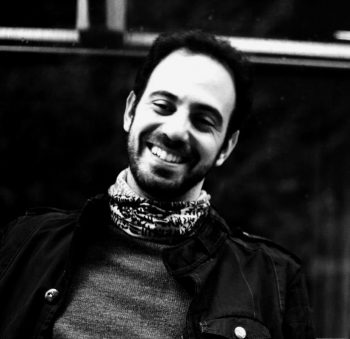
ESA flight surgeon Adrianos Golemis
Dr Adrianos Golemis is an ESA flight surgeon, monitoring the health of European astronauts before, during and after spaceflight. He is currently in Baikonur, Kazakhstan for the launch of Luca Parmitano where he is supporting Luca through a period of medical quarantine ahead of his launch to the International Space Station. The following post was written by him as a firsthand account of his experience.
The cosmodrome.
I can’t escape my origins as my brain instantly analyses the etymology: Κόσμος (cosmos), meaning “the world, our universe”, and -δρόμιο (-drome), “the way” or “path”. But “universe” is not the only meaning that the word cosmos held to the ancient Greeks. It also meant “social”, as in cosmo-politan. It was a reference to the people, particularly in gatherings (ο κόσμος), or even in a funny way (ο κοσμάκης)! My favourite meaning of this word, however, is “jewel” and its derivatives are still used in modern Greek today (κόσμημα).
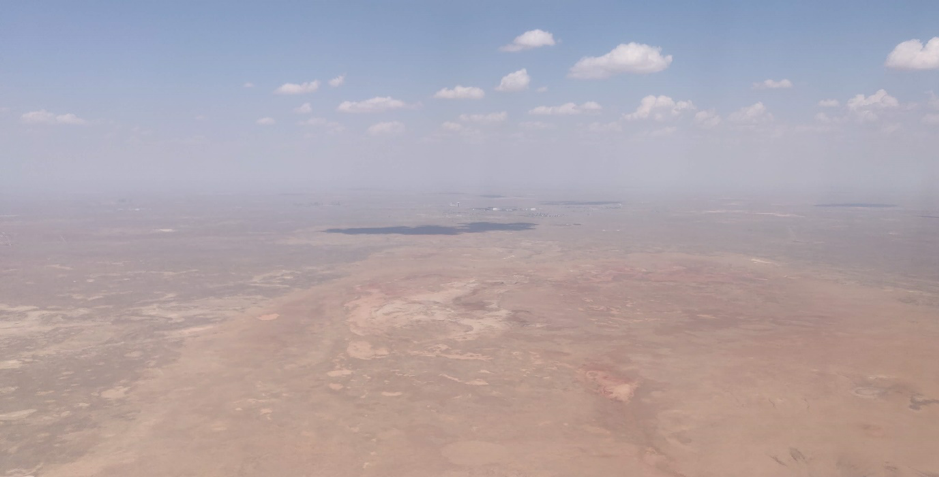
The thinly populated Kazakh steppe is the ideal landscape for space launches and landings. ESA-A.Golemis
Amid the desolation of the steppe, almost ironically, the cosmodrome at Байконур constitutes a pathway to the jewels of the sky. It’s an access point leading to heights above our world and the gemstones of the universe that surrounds us. For many of us, it was a childhood dream just to be here – let alone to work here and experience a launch.
After a three hour flight on the GCTC aircraft, we land at Крайний (Krainiyi) where we have to carry all our heavy bags once more, this time under the unforgiving Kazakh sun. The temperature during our stay will rise to 40⁰C and hydration is of paramount importance.
A purple bus with the inscription “Звездный” (starry) awaits our arrival and will drive us to Baikonur and the Cosmonaut Hotel. The local time zone is somewhat peculiar and our phones keep switching between UTC+5 and UTC+6.
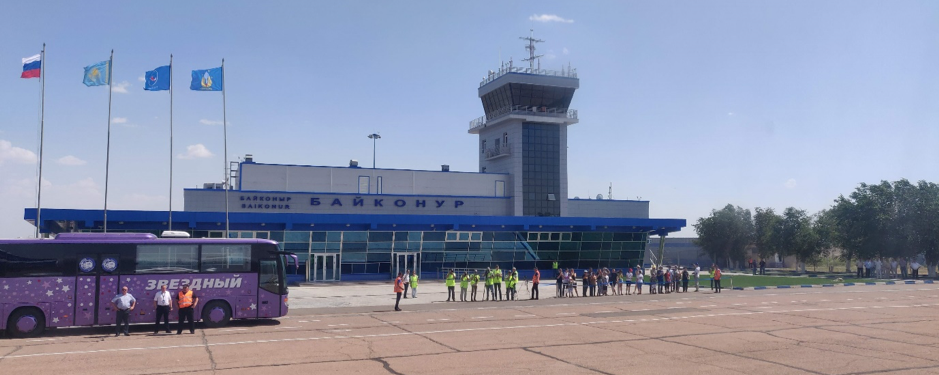
Krainiyi airport and the purple bus. ESA-A.Golemis
As we cross the fence encircling the hotel’s premises and enter into “quarantine”, I realise that (with a few short exceptions) this is where we will be for the next 16 days. Everything in this installation is controlled in order to prevent the potential spread of disease. That includes sanitation, regulated ambient temperature and precautions against insects and animals. We only consume bottled water and meals are prepared to certain hygiene standards. We disinfect our hands frequently and avoid close contact.
On the medical side, our body temperatures are measured every morning to ensure we haven’t caught a cold. Then myself and my fellow doctors conduct a short medical check of the astronauts.
Among other things, we control the crew’s weight. This needs to be stable so that the engineers can precisely calculate the Soyuz’s centre of mass, which will affect the spacecraft’s attitude during spaceflight.
Despite the language barrier, the hospitality of our Russian colleagues at Baikonur is eminent. Isolation and its limitations, the international flavour together with the feeling of being on a mission bring back memories from my DC10 winterover in Antarctica. There, ESA conducts medical research at Concordia Station, a French-Italian base that simulates some of the challenges of living in space for a year.
[ngg src=”galleries” ids=”4″ display=”basic_thumbnail”]There is a certain routine that takes hold in the Cosmonaut Hotel and the crew has come to call this somewhat monotonous repetition “The Groundhog Day”, after the eponymous 1993 movie. Breakfast is at 10:00, tilt table at 11:30, lunch at 15:00, team meeting at 15:45, photo signing 16:00-17:00, dinner at 20:00, watching a film at 21:00. And repeat. In between, the cosmonauts and astronauts attend classes, exercise, train and give interviews.
Getting to know Luca, Sasha (Alexander) and Drew a bit more these days is very fulfilling. And peeking into all their past training and busy schedules, one has to admit: the path to the jewels is hard-trodden. It is mind-blowing in a way to realise that the three of them will soon depart the shelter of this planet and live for several months above the clouds, in isolation and confinement, with limited supplies, near-zero day-to-day variability and even potential exposure to additional health risks. All in the name of science, in the unique conditions of microgravity. For us Europeans, all for Luca’s ESA mission “Beyond”.
Ϡ The Great BEYOND, by REM:
https://youtu.be/2Bh0vp0CjEo
During our stay, we get very few chances to catch a glimpse of the real Baikonur, and we only get that by glancing through the bus windows during door-to-door drives to mission-related locations. When we arrive at such a location, we and the people we meet keep a two meter distance and wear white coats and masks at all times to respect the rules of our medical isolation. One of these places is the hangar where the crew’s Союз (Soyuz) vehicle is stationed. This is the day of the “fit check”, when the crew and all their equipment get into their anchored spacecraft as a final test before the flight.
The fit check is an interesting and busy day for the medical team at Baikonur. While the crew conduct leak tests with their spacesuits and try to fit into the tiny seats of their vehicle fully suited, we need to make sure that all their kits of medical supplies are placed at the right spots. We go over the registries and cross-check the reference numbers on the Latin character and Cyrillic lists. This moment is also the last chance to get any additional necessary items on the Союз spacecraft.
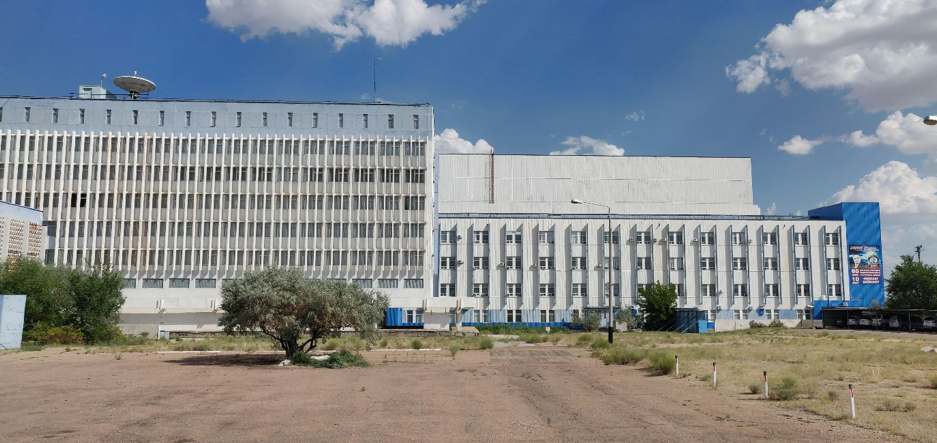
The Soyuz spacecraft hangar, where the fit check takes place. ESA-A.Golemis
The good thing about supporting human spaceflight is that sometimes you also get to try part of the astronaut training yourself. Having worked on bedrest studies for MEDES at the Clinique Spatiale in Toulouse, I could not pass up the opportunity to try the Russian tilt table physiology exercise.
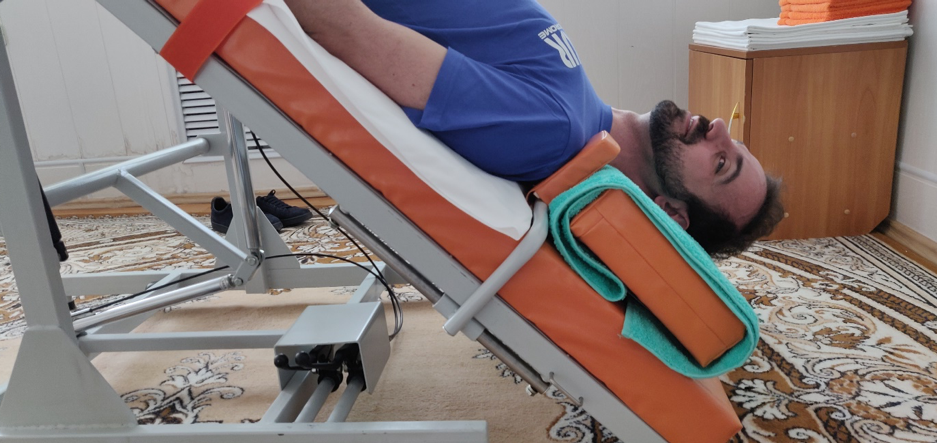
Trying 30 minutes of alternating between head-up and head-down tilt.
Cosmonauts have been going through this since the early days of spaceflight as a means to potentially improve the reaction of their cardiovascular system to the lack of gravity: in space, the blood and fluids of your body shift towards your head, so it’s good to be prepared! As the name suggests, the tilt table is actually a bed that can be tilted so that the person lying on it will alternate every minute between inclined positions, with feet higher than the head or the other way around. Another Russian countermeasure is the infamous rotating chair that spins you while you move your head with eyes closed. It’s an effort to adapt your vestibular system’s tolerance to changes, to avoid nausea in space.
Outside of these standard daily activities, there are few occasions that feel different – and we cherish them. Two of these are the raising of the flags and planting trees for each person that flies on a Союз.
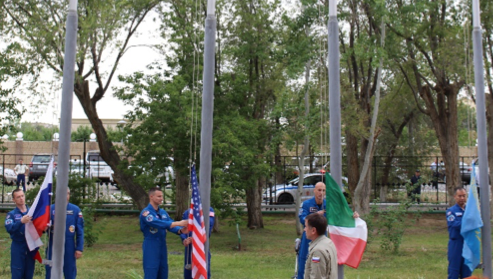
Raising of the Flags ceremony in quarantine. ESA-A.Golemis
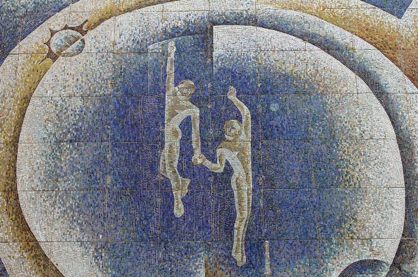
The huge cosmonautics mosaic at the hotel. ESA-A.Golemis
As the days of the quarantine pass and the launch draws near, a few humans train while in waiting to embark on the path to the jewels. From the barren lands surrounding the launch complex, we bid you farewell.
See you for launch. ҉
Find out more about launch preparations in Baikonur, Kazakhstan in episode 2 of podcast ESA Explores. Throughout the Beyond series, we’ll be covering different aspects of Luca’s second mission to the International Space Station in conversation with ESA experts. Tune into ESA Explores on Apple podcasts, Spotify, Stitcher, Podbean, Soundcloud or wherever you get your podcasts and follow @esaspaceflight on Twitter for the latest mission updates.



Discussion: no comments